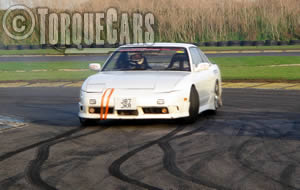The basic drifting techniques.
"A sideways glance"

The art of getting a car to go sideways is a delicate balance, and one which requires a great deal of skill and concentration. We shall assume that you have a suitably equipped and tuned RWD car that is drift ready with a locked rear diff.
NEVER EVER ATTEMPT TO DRIFT ON A STREET OR IN A PUBLIC AREA. Many clubs and tracks offer a safe venue for drift practice.
Torquecars will cover the most popular drift techniques which generally will combine together to create the other techniques. By learning a few methods you can combine them to match your personal style, the car setup and meet the track and apex conditions with the perfect drift. The better you get the faster you can drift.
Some techniques only really become effective at fast speeds. These techniques in particular should not be attempted unless you have attained an intuitive level of drift control at slower speeds and can control the car's direction as well as holding a drift.
Power over - Using the throttle to cause a power surge causing the rear wheels to lose traction. Pressing hard on the throttle will cause the wheels to spin faster than the travel of the car and this loss of traction effectively causes the rear of the car to go light. If you are already steering into a bend the back will go wide, if you are traveling straight a steering motion will start the drift.
Feint - Steering into the corner first and as the car is just about to settle into the bend a flick of the wrist in the other direction will upset the cars traction causing the rear to break free. The Scandinavian flick as popularised in the world of rally is a very similar technique. Using a feint technique it is possible to drift a front wheel drive car if you have enough speed. It is possible to drift a car using the inertia of the car caused by deceleration into a bend without using the Feint.
Clutch Kick - dipping the clutch to disengage the drive then reapplying it suddenly. The aim here is to use the different engine to road speed (either higher or sometimes lower) to initiate an over steer skid which can be held in a drift. You will need a meaty clutch for this and often the drivetrain, gearbox or diff will prematurely fail.
Handbrake - Sometimes, depending on speed and the apex of the bend, drifters may use the handbrake to initiate the drift, and as such it is a useful way to break the rear traction, saving the clutch and drivetrain. A drifter will combine this with the other methods described to catch and continue a drift otherwise the car will slow up or spin out. This is also what the FWD kids do in supermarket car parks which is not cool and not drifting - the aim is for a sustained drift.

So now the rear of the car is running wide we need to keep it balanced. The key here is to use gentle and progressive controls. Steering motions need to be fluid rather than jerky. Throttle application likewise also needs to be progressive and steady.
This is what distinguishes a pro from an amateur and the feel only comes from hours of practice. It will become second nature.
To stop an over steer skid you steer into the direction of the rear skid, to make it worse you steer the other way. (ie: If the rear slides out to the left, you have steer to the left in order to catch this and prevent a spin or steer to the right to make it worse and create a spin!) In drifting you want to maintain the fine balance between over steer and running straight.
What if you overcook it and the car spins? Stay calm and do not panic. The car will generally complete a 180 degree turn and come to a stop. When the car has lost its speed be quick to apply the brake to prevent the car rolling into a barrier or worse still another driver.
The holy grail of drifting is a long "driftlock" - being able to hold a steady drift vector for as long as possible at a fast pace. The greater the angle and faster the drift the more points are awarded. In car GPS measures the angle and speed of drift and allows an easily judgeable benchmark for practice runs. Most competitions have judges who award points on speed, style and angle of drift.
Feel free to join us in our tuning forum and discuss drifting techniques (if you are a serious drifter), read up on drift events and all aspects of drift car setup with our resident drifting fanatics and fans.
Please Check out my YouTube channel, we're regularly adding new content...
PLEASE HELP: I NEED YOUR DONATIONS TO COVER THE COSTS OF RUNNING THIS SITE AND KEEP IT RUNNING. I do not charge you to access this website and it saves most TorqueCars readers $100's each year - but we are NON PROFIT and not even covering our costs. To keep us running PLEASE Donate here
If you liked this page please share it with your friends, drop a link to it in your favourite forum or use the bookmarking options to save it to your social media profile.
Feedback - What do You Think?
Please use our forums if you wish to ask a tuning question, and please note we do not sell parts or services, we are just an online magazine.
Help us improve, leave a suggestion or tip
Please watch this video and subscribe to my YouTube channel.

 Click to accept YouTube Cookies & Play.
Click to accept YouTube Cookies & Play.